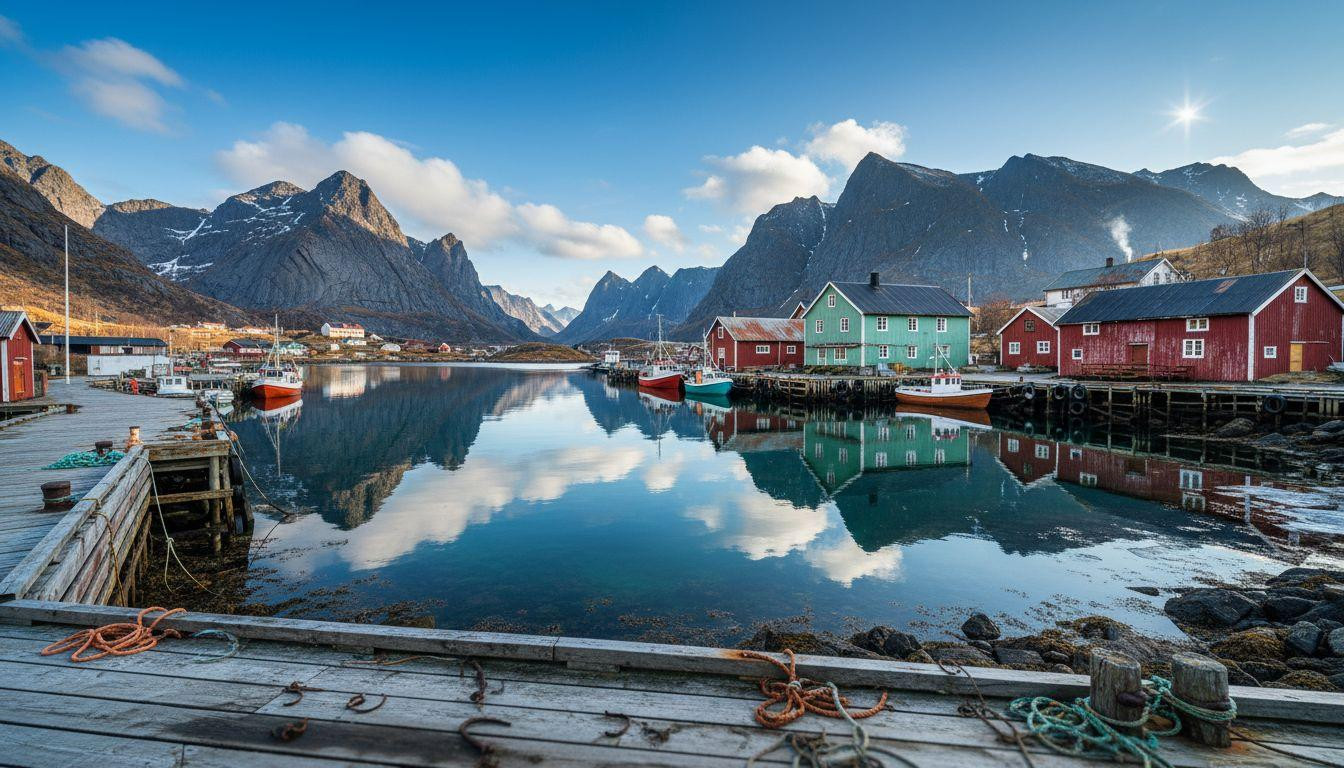The admission booth stands empty at 6:45 AM in November. Arctic wind cuts through the parking area. At 7:00 AM sharp, the gate opens to Nusfjord, Norway’s most authentic fishing village, where a $10 entrance fee transforms overtourism into morning solitude.
Red and yellow rorbuer cabins line the harbor in perfect silence. Steam rises from a single window in the 1907 general store. The scent of dried cod drifts across wooden boardwalks where your footsteps echo alone.
The controversial entrance fee that filters crowds
Nusfjord charges 100 NOK ($10) per person, making it the only Lofoten village requiring payment to enter. Local tourism boards confirm this fee funds preservation of 50 historic buildings dating to the 1800s. The controversial charge splits visitors into two camps.
Recent visitor surveys reveal the fee’s hidden purpose. While 90,000 annual tourists visit during summer, November sees only 35-45 daily visitors. The entrance barrier naturally selects travelers willing to pay for authentic experience over free but crowded alternatives.
Summer brings 50 tour buses daily to this village of 28 permanent residents. The mathematical result: 2,000 tourists per resident on peak July days. Newport’s mansion crowds pale compared to Nusfjord’s overtourism ratio.
What morning silence reveals in November
The harbor before tourists arrive
Harbor water reflects cabin walls in perfect mirror calm. Three fishing boats bob at traditional moorings, maintained for actual use rather than display. The cod-liver oil workshop chimney releases thin smoke, signaling production continues as it has since the mid-1800s.
November temperatures hover between 28°F and 39°F. Harbor edges show partial ice formation, creating natural frames for Northern Lights reflections. The forge operates Tuesday through Saturday, functioning as both museum exhibit and working blacksmith shop.
Authentic preservation without theater
Unlike Colonial Williamsburg’s costumed performances, Nusfjord maintains genuine working elements. The general store serves 28 year-round residents, unchanged since 1907. Stockfish production continues for global export, not tourist demonstration.
UNESCO designated Nusfjord in 1975 as one of three Norwegian pilot preservation projects. Some rorbuer cabins date back several centuries, now converted from fishermen’s housing to luxury accommodation at $385 nightly.
The winter fishing village experience
Activities during Arctic darkness
November daylight lasts only 4-5 hours, from 9:18 AM to 2:45 PM. This limitation creates urgency around outdoor activities. The lighthouse path offers 30-minute walks through sparse vegetation, frequently muddy and requiring hiking boots.
Northern Lights appear 60% of clear nights between 6 PM and 1 AM. Boothbay Harbor’s working fleet mirrors Nusfjord’s authentic maritime character, though without aurora displays.
Local food and traditional crafts
Karoline Restaurant serves pan-seared Arctic char ($69.50) and reindeer stew ($64.50) with panoramic fjord views. Landhandleriet Café offers traditional waffles ($12.50) inside the jade-green general store.
The workshop produces golden cod-liver oil using 150-year-old methods. Fresh seafood features catch-of-the-day preparation highlighting pristine Arctic quality. Reine’s mountain-backed harbor sits 18 miles south, offering similar Lofoten fishing village authenticity.
The privilege of earned solitude
The entrance fee creates what economists call artificial scarcity. Summer visitors complain about the charge, but November travelers understand its value. Those willing to wake before sunrise and pay $10 gain access to something increasingly rare.
Travel research published in 2025 shows Nusfjord’s morning visitor count averages 5-10 people between 7-9 AM in November. Compare this to free destinations where authentic atmosphere vanishes under tourist pressure. The fee functions as crowd management rather than money grab.
Svolvær’s gateway status brings heavier traffic 28 miles north, making Nusfjord’s relative isolation more valuable.
Your questions about Nusfjord’s fishing village answered
Is the $10 entrance fee justified?
For early morning arrivals, absolutely. The fee filters day-trippers who resist paying, creating natural crowd control. According to regional visitor centers, paid admissions fund preservation of structures dating to the 1800s while maintaining authentic working village elements.
How does winter differ from summer visits?
Summer brings midnight sun but 50 daily tour buses and crowds on wooden boardwalks. November offers 4-5 hours daylight, Northern Lights possibilities, and genuine solitude with only 35-45 daily visitors. Trade continuous daylight for aurora and authenticity.
What makes this different from typical tourist villages?
Working harbor with actual residents plus functioning workshops. The cod scent, active fishing boats, and preservation efforts remain genuine rather than theatrical. Unlike reconstructed attractions, Nusfjord maintains economic dependence on both fishing and tourism.
Morning light reveals what the entrance fee protects. Wooden boardwalks creak under solitary footsteps. Harbor water reflects red cabin walls undisturbed by crowds. In November, Nusfjord belongs to those willing to pay for authentic Arctic silence.
